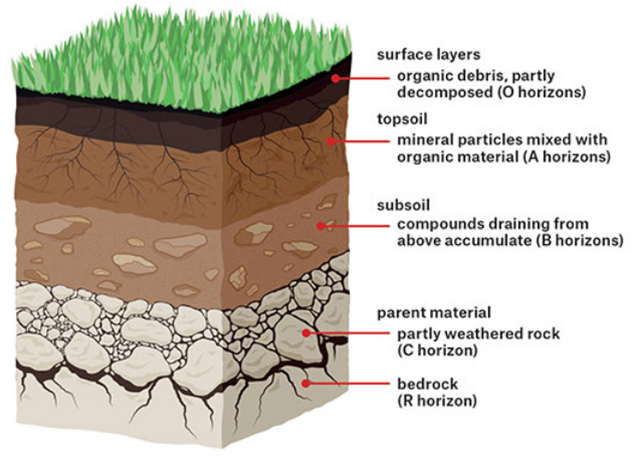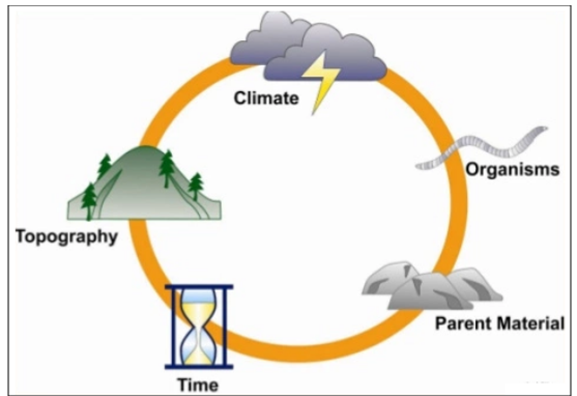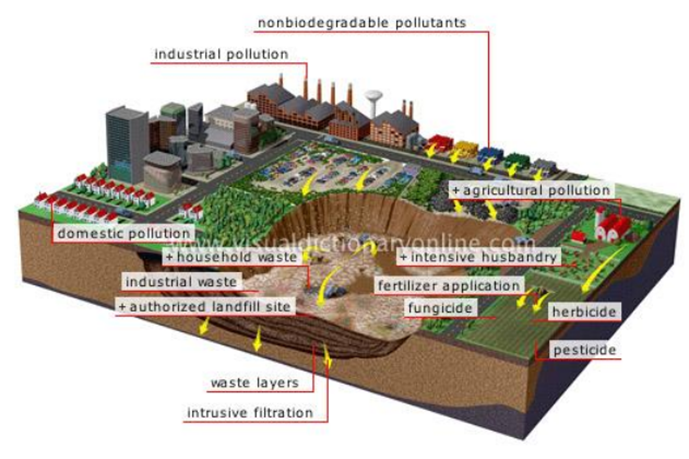SOIL
It is a mixture. It is the portion of earth surface consisting of various components like small particles of rock (of different sizes, bits of decayed living organisms which are called humus, various forms of microscopic life, air and water.
Soil Profile
• The soil is found in several layers which are arranged as the soil is formed.
• The layers of the soil are also called as Horizons.
• These layers have different types of soil particles and colour and hands are differentiated on this basis.
• The soil profile is defined as the vertical section of soil that represents the sequence of layers to the soil.
• The layers of the soils help in understanding the usage of that soil.
• The soil mainly consists of four layers. Such a soil is called Mature Soil.
• Some types of soils consist of two layers only. They are called Immature Soils.
The Layers or Horizon of Soil
1. The Topsoil or Horizon A or the Humus Layer
• This layer of soil consists of organic matter and decomposed substances.
• It is dark in colour, porous and can hold air and water in good amounts.
• Due to such quality, many living organisms are found in the topsoil, for example, the earthworms, fungi and bacteria.
Horizon O
Some soils contain a layer of organic matter which consists of a large number of decomposed leaves and humus. It is called the organic layer of the soil.
2. Subsoil or Horizon B

• It lies below the topsoil. It is hard and compact than the topsoil.
• The subsoil has a light colour because it does not contain much humus.
• The subsoil does not contain much organic matter other but contains minerals in good quantity and metal salts like iron oxide.
• When farmers plough their field, they often mix the topsoil and subsoil so that the crops can grow easily.
3. Horizon C or Regolith
This layer lies beneath the subsoil layer.
It is very hard and consists of stones and partly weather pieces of rocks. There is no organic matter in this layer. The roots of plants and trees cannot penetrate up to this layer.
4. Horizon R or Bedrock
This is the last layer of the soil which consists of un weathered rocks
Factors affecting the formation of Soil
- The Sun -
• It is responsible for breaking down the rocks into smaller pieces and forming cracks in between them.
• The sun's radiations heat up the rocks during the daytime. As a result, the rocks expand.
• But during the night, these rocks cool down and therefore contract.
• All the parts of the rocks may not cool down or heat up at the same time.
• All this leads to the formation of cracks in them and ultimately breaks them down.
2. Water –
• Water gets into the cracks of the rocks and freezes down there.
• This leads to whitening of the cracks.
• Flowing water often carries pieces of rocks away and on that path, they get broken down into smaller pieces as they rub against each other and also due to the pressure of the flowing water. This is one of the reasons why soil is formed far away from the parent Rock.
3. Winds –
• Winds can wear down the rocks and break them.
• Strong winds rub against the rocks and break them or wear them down just like water.
• Winds also carry away the soil or sand from one place to another.
4. Living organisms –
• Lichens that can grow on the rocks and secrete a certain substance that can powder down a rock which leads to the formation of soil.
• Small plants such as moss often grow on rocks and break them down.
• It may also happen that the roots of different plants and trees get into the rock’s surface and break it down or widen the cracks.

Soil is a mixture of various substances It contains the following:
• Small pieces of rocks
• Bits of decayed living organisms called the Humus
• Microscopic organisms
• Minerals and nutrients
Factors that decide the type of soil
• The amount of humus present in the soil – the more the humus the more porous and deep the soil is.
• The number of microscopic organisms in the soil – they help in keeping it fertile
• The parent rocks – they decide the minerals that are present in the soil
Soil Pollution
We know that soil contains different types of substances all of them are responsible for the sustenance of the biodiversity. When the useful components get removed from the soil, it loses its fertility and leads to a decrease in the microscopic life in it. This phenomenon is called soil pollution.
The Causes of Soil Pollution
• Long usage of fertilizers and pesticides leads to the killing of the microorganisms present in it. Without these organisms, the soil would not get recycled and replenished. Earthworms get killed because of the pesticides. They are the ones that lead to the formation of humus in the soil.
• Flowing water and winds can carry away the soil particles and often lead to exposure of rocks.
• Deforestation can also lead to soil pollution as the uprooting of trees exposes the soil to rains and winds.
• Industrial activities like mining and extraction of minerals can lead to a mixture of harmful chemicals in the soil and decay its quality.

Effects of Soil Pollution
• It severely affects the growth of plants.
• It can lead to infertility of soil and thus would restrict agriculture on such land.
• The fertilizers decay the quality of the soil.
• It can affect the health of human beings who consume food grown in soil which has large amounts of fertilizers and pesticides mixed in it.
• It can change the structure of soil thus decaying the growth of useful bacteria and other microorganisms in the soil.
Soil Erosion – It a process in which the upper layer of the soil gets washed away thus leading to degradation in the soil’s quality.
How can roots of plants prevents soil erosion?
• The roots of the plants bind the soil together and prevent the winds and flowing water to sweep away the soil particles.
• The plants also lead to the movement of water inside the soil and allow it to reach the deeper layer leading to an increase in the water retention of the soil and the underground water levels.

 Vaishnav Publication
Vaishnav Publication
